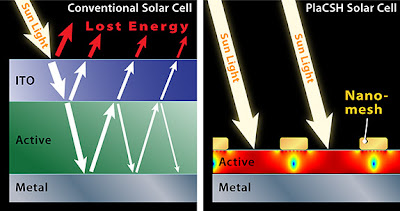NSL Scientists have overcome the core issue of Solar Cells: The unavailability to fully capture light that enters the cell and light reflecting from the cell. The Scientists rectified this issue using a nano structured sandwich of metal(gold) and plastic that collects and traps light.
Organic PlaCSH Solar Cells with 175% Increased Efficiency Developed
Rahul Prabhu | Renew India Campaign
In what is believed to be a breakthrough in the Solar Industry, A group of Electrical researches in NanoStructure Laboratory (NSL) at Princeton University, led by Stephen Chou, has found an economical and simple way which almost triples the efficiency of ordinary organic solar cells - the cheap and flexible plastic devices that many scientists believe could be the future of solar power.
NanoStructure Laboratory (NSL) at Princeton University focuses on Development of new nanotechnologies for fabricating structures substantially smaller, better, and cheaper than current technology permits, and explore innovative nanodevices and advanced materials in electronics, optics, optoelectronics, magnetics, and biology.
High Efficiency PlaCSH Solar Cells:
NSL Scientists have overcome the core issue of Solar Cells: The unavailability to fully capture light that enters the cell and light reflecting from the cell. The Scientists rectified this issue using a nano structured sandwich of metal(gold) and plastic that collects and traps light.
The sandwich also called the sub wavelength plasmonic cavity has an extraordinary ability to dampen reflection and trap light. This new technique is what allowed the researches to create a solar cell which reflects only 4 percent of light and absorbs as much as 96 percent. Also the New Technique demonstrates 52 percent higher efficiency in converting light to electrical energy than a conventional solar cell and leads to 175 percent total increase.
Dr. Chou said the technology also should increase the efficiency of conventional inorganic solar collectors, such as standard silicon solar panels, although he cautioned that his team has not yet completed research with inorganic devices.
How the New PlaCSH Solar Cells Work:
The top layer, known as the window layer, of the new solar cell uses an incredibly fine Gold mesh which is 30 nanometers thick, and each hole is 175 nanometers in diameter and 25 nanometers apart. This Golden Mesh replaces the conventional window layer in conventional Solar Cells typically made of a material called indium-tin-oxide (ITO).

The mesh window layer is placed very close to the bottom layer of the sandwich (can be seen in above image), the same Aluminum film used in conventional solar cells. In between the two metal sheets is a thin strip of semiconducting material, such as Silicon, plastic or gallium arsenide, which are commonly used in conventional solar panels. By Placing mesh window closer to the bottom, the cell structure achieves high efficiency at large angles (which is common during Cloudy days and if the Cell is not directly facing the Sun). By capturing these angled rays, the new structure boosts efficiency by an additional 81 percent, leading to the 175 percent total increase.
Gold Mesh Acts as a Black hole for light:
The New Organic PlaSCH Solar cell's gold mesh is created in such way that it traps the light it collects. The Mesh Spacing, thickness of the Sandwich and the diameter of mesh holes are designed in such a way that they are smaller than the wavelength of the light being collected. This is critical because the light behaves in very unusual ways in sub wavelength structures, which and these subwavelength structures helped them to create a nano trap in which traps the light which enters the Structure, and this leads to higher efficiency.
And Researchers call this trap as "Plasmonic Cavity with Sub Wavelength Hole Array" or PlaCSH. The Researches also demonstrated with an experiment the light absorbing Ability of PlaCSH cells by placing it under direct Sunlight and comparing it with Conventional Cells, and the results were quite astonishing. We can see from the Surface image of Conventional Organic Cells using ITO Electrode and PlaCSH Cells below that - under sunlight, a standard solar power cell looks tinted in color due to light reflecting from its surface, but the PlaCSH looks deep black because of the extremely low light reflection.


Not Just Efficient, Its Cheap too:
In addition to efficiency boost, the researches were also successful in introducing cost reduction by replacing the most expensive part of Organic Solar Cells- the ITO electrode with the thin film Mesh. Also these cells can be manufactured cost-effectively in the shape of sheets using low cost Printing Technology, which embosses nano structures over a large area, like printing a newspaper. These Structures are also promising for the existing Silicon technologies, which dominate the market as the PlaCSH sandwich captures light independent of what electricity-generating material is used as the middle layer leading to increased efficiency and also at the same time reducing the overall thickness of Solar Cells.
The Researches said that they will continue to refine this technology and increase it's efficiency, which will lead to commercialization of Organic PlaCSH Solar Cell.
Rahul R Prabhu is the Editor of Renew India Campaign, which is a major Green Blog in India. The Website provides info on Indian Renewable Landscape and other Technologies prevalent in the Indian Subcontinent.
The content & opinions in this article are the author’s and do not necessarily represent the views of AltEnergyMag
Comments (0)
This post does not have any comments. Be the first to leave a comment below.
Featured Product

